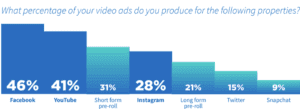
Alex Klaumenzer, senior media manager, Clinch
From gathering inspiration on Instagram to purchasing through mobile sites or apps, the way consumers shop has changed. Retailers should look to Facebook’s platforms to capture these consumers or fear missing out on the e-commerce boom.
However, posting “organically” is no longer enough. Facebook’s recent newsfeed algorithm change reiterates the platform’s focus on meaningful content and reinforces the necessity of advertising on its platforms. In 2017, the revenue Facebook generated from advertising was $39.9 billion. This number will continue to grow as retailer’s ramp up advertising efforts since their organic content will be de-prioritized
While branding is important on these platforms, Facebook offers comprehensive tools to grow sales. Retailers have the ability to drive sales at scale by combining their online product catalog with Facebook’s algorithms and e-commerce focused formats. Bottom line, retailers must stand out to efficiently drive sales and leverage Facebook’s algorithm that favors high performing creative.

A recent study by Clinch and Brand Innovators of more than 200 brand marketers found that Facebook is getting the largest share of video ads in 2018, surpassing YouTube.
Here are 4 things retailers must know about advertising on Facebook in 2018:
1. Forget Static. Take advantage of Facebook’s various video formats, including Instagram Stories to drive sales.
With limited space available in a crowded news feed, retailers who invest in video will have the upper hand over brands using static images. Facebook understands the value of video and is actively building new video formats such as Facebook Watch and Instagram Stories to encourage the growth of video on its platforms.
Retailers must know that when they are working with video on Facebook, it’s important to design for mobile-first. Ditch widescreen 16:9 video dimensions for square or vertical video. Square and vertical video offer an improved viewing experience, specifically on mobile.
Video creative should be short and simple. The news feed and the internet as a whole can overwhelm users with content. Aim for a video length between 6 and 15 seconds, while delivering key information within the first 4 seconds—you need to get the user to stop “thumb scrolling.” Lastly, take a chance with new video offerings, such as Instagram Stories and Facebook Collection. Early adopters can enjoy lower cost per impression (CPM) and higher return on ad spend (ROAS).
2. If A/B testing is important in display, A/B testing is critical for success in video.
Unless you can see into the future, A/B testing is critical to determine the best-performing creative for each target audience. Testing video creative can be overwhelming with an unlimited number of elements to optimize. Start with the basics by testing 2 to 4 different creative styles.
Once a winner is identified, test creative variables to maximize conversion opportunities. In display, we’ve found the simple change of a call-to-action can result in 6x sales lift. Additional variables to test include different messaging, color, Facebook placements, audiences, video dimensions, and video length. For valid insights, ensure only one variable is tested a time.
3. Personalize Creative and Messaging.
Scalable video personalization is one of the fastest-growing trends for 2018. The ability to personalize video beyond demographics allows retailers to turn video from a branding tool to a direct response opportunity.
Personalization gives retailers the ability to provide a relevant and a positive experience, boosting campaign click through rates and conversions. Remember there is a limit to how far brands should personalize. Ask yourself if the personalized creative provides value to the user experience. If the answer is yes, personalize!
UNIQLO USA is a good example of a retailer with strong traditional assets that can be recreated into square or vertical personalized video ads. This video can be further personalized by gender, location, and time for a relevant viewing experience.
To personalize by gender, UNIQLO should highlight footage with the most relevant products for men and women. To drive in-store visits, UNIQLO can include a map with nearby stores based on each viewer’s proximity. Lastly, personalizing the creative style to match the time of day. Video ads served during the morning or mid-day should focus more on daytime activities while staying true to the 24-Hour Jeans creative strategy.
4. Data, data, and data.
Leverage data to personalize, target, and gain insights, and let Facebook do all the work. Facebook has unparalleled interest and behavior-based data. When combined with first-party data, retailers have the ability to scale and segment campaigns efficiently.
Utilize first-party data with Facebook’s lookalike audiences to find new customers. To maximize conversions, segment first-party data by high-value purchasers before uploading to Facebook. Pair this lookalike audience with A/B tested video creative for a prospecting campaign that stands out in the news feed.
Gather actionable insights to personalize and optimize campaigns with Facebook’s reporting tools. Retailers can filter campaign analytics by gender, geographic location, time of day, device, and more to discover optimization opportunities. Combine this data with website analytics and product data to identify high value audiences or creative.
Early adopters will benefit, but innovators will stand out.
Video will continue its tremendous growth in 2018, but retailers need to take additional steps to stand out in a crowded news feed that prioritizes paid video over organic content. Retailers who take advantage of personalized video, powered by data and A/B testing, will find themselves leading the pack with increased return on ad spend and sales lift.
Clinch specializes in producing personalized video ads and other forms of online advertising.
Favorite